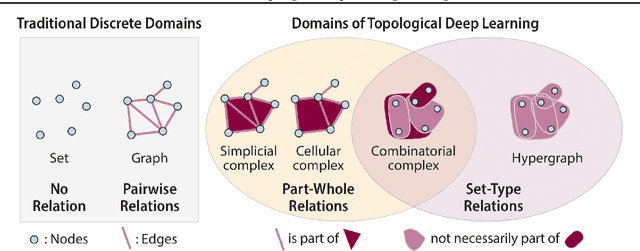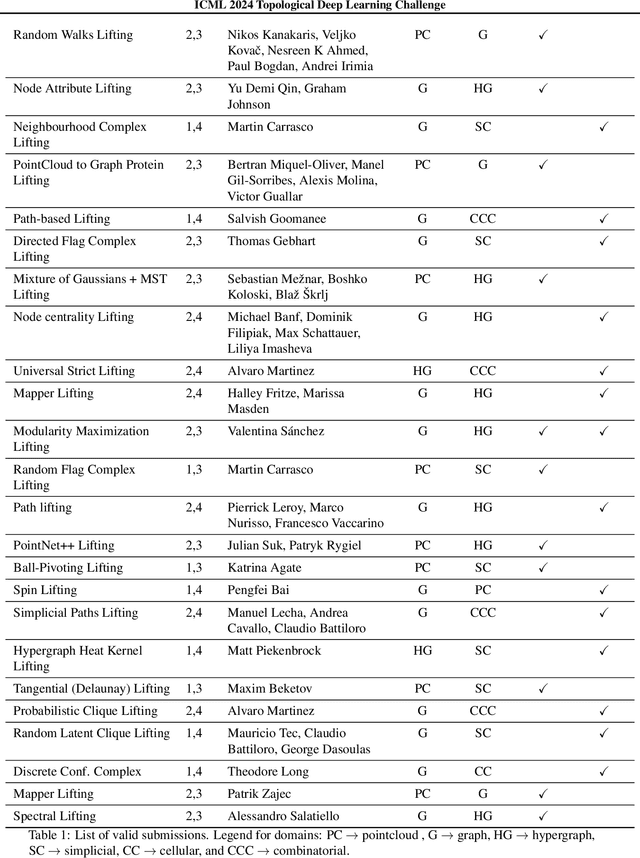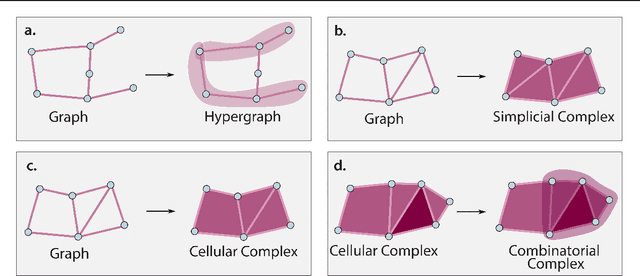Erik Bekkers
University of Amsterdam
AdS-GNN -- a Conformally Equivariant Graph Neural Network
May 19, 2025Abstract:Conformal symmetries, i.e.\ coordinate transformations that preserve angles, play a key role in many fields, including physics, mathematics, computer vision and (geometric) machine learning. Here we build a neural network that is equivariant under general conformal transformations. To achieve this, we lift data from flat Euclidean space to Anti de Sitter (AdS) space. This allows us to exploit a known correspondence between conformal transformations of flat space and isometric transformations on the AdS space. We then build upon the fact that such isometric transformations have been extensively studied on general geometries in the geometric deep learning literature. We employ message-passing layers conditioned on the proper distance, yielding a computationally efficient framework. We validate our model on tasks from computer vision and statistical physics, demonstrating strong performance, improved generalization capacities, and the ability to extract conformal data such as scaling dimensions from the trained network.
Clifford Group Equivariant Diffusion Models for 3D Molecular Generation
Apr 22, 2025Abstract:This paper explores leveraging the Clifford algebra's expressive power for $\E(n)$-equivariant diffusion models. We utilize the geometric products between Clifford multivectors and the rich geometric information encoded in Clifford subspaces in \emph{Clifford Diffusion Models} (CDMs). We extend the diffusion process beyond just Clifford one-vectors to incorporate all higher-grade multivector subspaces. The data is embedded in grade-$k$ subspaces, allowing us to apply latent diffusion across complete multivectors. This enables CDMs to capture the joint distribution across different subspaces of the algebra, incorporating richer geometric information through higher-order features. We provide empirical results for unconditional molecular generation on the QM9 dataset, showing that CDMs provide a promising avenue for generative modeling.
On the Importance of Embedding Norms in Self-Supervised Learning
Feb 13, 2025Abstract:Self-supervised learning (SSL) allows training data representations without a supervised signal and has become an important paradigm in machine learning. Most SSL methods employ the cosine similarity between embedding vectors and hence effectively embed data on a hypersphere. While this seemingly implies that embedding norms cannot play any role in SSL, a few recent works have suggested that embedding norms have properties related to network convergence and confidence. In this paper, we resolve this apparent contradiction and systematically establish the embedding norm's role in SSL training. Using theoretical analysis, simulations, and experiments, we show that embedding norms (i) govern SSL convergence rates and (ii) encode network confidence, with smaller norms corresponding to unexpected samples. Additionally, we show that manipulating embedding norms can have large effects on convergence speed. Our findings demonstrate that SSL embedding norms are integral to understanding and optimizing network behavior.
On the Utility of Equivariance and Symmetry Breaking in Deep Learning Architectures on Point Clouds
Jan 01, 2025Abstract:This paper explores the key factors that influence the performance of models working with point clouds, across different tasks of varying geometric complexity. In this work, we explore the trade-offs between flexibility and weight-sharing introduced by equivariant layers, assessing when equivariance boosts or detracts from performance. It is often argued that providing more information as input improves a model's performance. However, if this additional information breaks certain properties, such as $\SE(3)$ equivariance, does it remain beneficial? We identify the key aspects of equivariant and non-equivariant architectures that drive success in different tasks by benchmarking them on segmentation, regression, and generation tasks across multiple datasets with increasing complexity. We observe a positive impact of equivariance, which becomes more pronounced with increasing task complexity, even when strict equivariance is not required.
Pullback Flow Matching on Data Manifolds
Oct 06, 2024Abstract:We propose Pullback Flow Matching (PFM), a novel framework for generative modeling on data manifolds. Unlike existing methods that assume or learn restrictive closed-form manifold mappings for training Riemannian Flow Matching (RFM) models, PFM leverages pullback geometry and isometric learning to preserve the underlying manifold's geometry while enabling efficient generation and precise interpolation in latent space. This approach not only facilitates closed-form mappings on the data manifold but also allows for designable latent spaces, using assumed metrics on both data and latent manifolds. By enhancing isometric learning through Neural ODEs and proposing a scalable training objective, we achieve a latent space more suitable for interpolation, leading to improved manifold learning and generative performance. We demonstrate PFM's effectiveness through applications in synthetic data, protein dynamics and protein sequence data, generating novel proteins with specific properties. This method shows strong potential for drug discovery and materials science, where generating novel samples with specific properties is of great interest.
ICML Topological Deep Learning Challenge 2024: Beyond the Graph Domain
Sep 08, 2024


Abstract:This paper describes the 2nd edition of the ICML Topological Deep Learning Challenge that was hosted within the ICML 2024 ELLIS Workshop on Geometry-grounded Representation Learning and Generative Modeling (GRaM). The challenge focused on the problem of representing data in different discrete topological domains in order to bridge the gap between Topological Deep Learning (TDL) and other types of structured datasets (e.g. point clouds, graphs). Specifically, participants were asked to design and implement topological liftings, i.e. mappings between different data structures and topological domains --like hypergraphs, or simplicial/cell/combinatorial complexes. The challenge received 52 submissions satisfying all the requirements. This paper introduces the main scope of the challenge, and summarizes the main results and findings.
Can strong structural encoding reduce the importance of Message Passing?
Oct 22, 2023Abstract:The most prevalent class of neural networks operating on graphs are message passing neural networks (MPNNs), in which the representation of a node is updated iteratively by aggregating information in the 1-hop neighborhood. Since this paradigm for computing node embeddings may prevent the model from learning coarse topological structures, the initial features are often augmented with structural information of the graph, typically in the form of Laplacian eigenvectors or Random Walk transition probabilities. In this work, we explore the contribution of message passing when strong structural encodings are provided. We introduce a novel way of modeling the interaction between feature and structural information based on their tensor product rather than the standard concatenation. The choice of interaction is compared in common scenarios and in settings where the capacity of the message-passing layer is severely reduced and ultimately the message-passing phase is removed altogether. Our results indicate that using tensor-based encodings is always at least on par with the concatenation-based encoding and that it makes the model much more robust when the message passing layers are removed, on some tasks incurring almost no drop in performance. This suggests that the importance of message passing is limited when the model can construct strong structural encodings.
Artificial Intelligence for Science in Quantum, Atomistic, and Continuum Systems
Jul 17, 2023Abstract:Advances in artificial intelligence (AI) are fueling a new paradigm of discoveries in natural sciences. Today, AI has started to advance natural sciences by improving, accelerating, and enabling our understanding of natural phenomena at a wide range of spatial and temporal scales, giving rise to a new area of research known as AI for science (AI4Science). Being an emerging research paradigm, AI4Science is unique in that it is an enormous and highly interdisciplinary area. Thus, a unified and technical treatment of this field is needed yet challenging. This paper aims to provide a technically thorough account of a subarea of AI4Science; namely, AI for quantum, atomistic, and continuum systems. These areas aim at understanding the physical world from the subatomic (wavefunctions and electron density), atomic (molecules, proteins, materials, and interactions), to macro (fluids, climate, and subsurface) scales and form an important subarea of AI4Science. A unique advantage of focusing on these areas is that they largely share a common set of challenges, thereby allowing a unified and foundational treatment. A key common challenge is how to capture physics first principles, especially symmetries, in natural systems by deep learning methods. We provide an in-depth yet intuitive account of techniques to achieve equivariance to symmetry transformations. We also discuss other common technical challenges, including explainability, out-of-distribution generalization, knowledge transfer with foundation and large language models, and uncertainty quantification. To facilitate learning and education, we provide categorized lists of resources that we found to be useful. We strive to be thorough and unified and hope this initial effort may trigger more community interests and efforts to further advance AI4Science.
$\mathrm{E}(n)$ Equivariant Message Passing Simplicial Networks
May 11, 2023Abstract:This paper presents $\mathrm{E}(n)$ Equivariant Message Passing Simplicial Networks (EMPSNs), a novel approach to learning on geometric graphs and point clouds that is equivariant to rotations, translations, and reflections. EMPSNs can learn high-dimensional simplex features in graphs (e.g. triangles), and use the increase of geometric information of higher-dimensional simplices in an $\mathrm{E}(n)$ equivariant fashion. EMPSNs simultaneously generalize $\mathrm{E}(n)$ Equivariant Graph Neural Networks to a topologically more elaborate counterpart and provide an approach for including geometric information in Message Passing Simplicial Networks. The results indicate that EMPSNs can leverage the benefits of both approaches, leading to a general increase in performance when compared to either method. Furthermore, the results suggest that incorporating geometric information serves as an effective measure against over-smoothing in message passing networks, especially when operating on high-dimensional simplicial structures. Last, we show that EMPSNs are on par with state-of-the-art approaches for learning on geometric graphs.
Interpretable ECG classification via a query-based latent space traversal (qLST)
Nov 19, 2021



Abstract:Electrocardiography (ECG) is an effective and non-invasive diagnostic tool that measures the electrical activity of the heart. Interpretation of ECG signals to detect various abnormalities is a challenging task that requires expertise. Recently, the use of deep neural networks for ECG classification to aid medical practitioners has become popular, but their black box nature hampers clinical implementation. Several saliency-based interpretability techniques have been proposed, but they only indicate the location of important features and not the actual features. We present a novel interpretability technique called qLST, a query-based latent space traversal technique that is able to provide explanations for any ECG classification model. With qLST, we train a neural network that learns to traverse in the latent space of a variational autoencoder trained on a large university hospital dataset with over 800,000 ECGs annotated for 28 diseases. We demonstrate through experiments that we can explain different black box classifiers by generating ECGs through these traversals.
 Add to Chrome
Add to Chrome Add to Firefox
Add to Firefox Add to Edge
Add to Edge